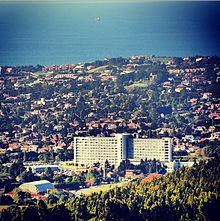Peri-urbanisation



Peri-urbanisation relates to those processes of dispersive urban growth that creates hybrid landscapes of fragmented urban and rural characteristics.
Origin
The expression originates from the French word périurbanisation, which is even used by INSEE[1] (the French statistics agency) to describe spaces—between the city and the countryside—that are shaped by the urbanisation of former rural areas in the urban fringe, both in a qualitative (e.g. diffusion of urban lifestyle) and in a quantitative (e.g. new residential zones) sense. It is frequently seen as a result of post-modernity—(not post-modernism). In science, the term was used initially in France and Switzerland.
Structure and function
Peri-urban areas (also called rurban space, outskirts or the hinterland) are defined by the structure resulting from the process of peri-urbanisation. It can be described as the landscape interface between town and country,[2] or also as the rural—urban transition zone where urban and rural uses mix and often clash.[3] It can thus be viewed as a landscape type in its own right, one forged from an interaction of urban and rural land use.
Its definition shifts depending on the global location, but typically in Europe where urban areas are intensively managed to prevent urban sprawl and protect agricultural land, the urban fringe will be characterised by certain land uses which have either purposely moved away from the urban area, or require much larger tracts of land. As examples:
- Roads, especially motorways and bypasses
- Waste transfer stations, recycling facilities and landfill sites
- Park and ride sites
- Airports
- Large hospitals
- Power, water and sewerage facilities
- Factories
- Large out-of-town shopping facilities e.g. large supermarkets
Despite these urban uses, the fringe remains largely open with the majority of the land agricultural, woodland or other rural use. However the quality of the countryside around urban areas tends to be low with severance between areas of open land and badly maintained woodlands and hedgerows.
Apart from the structural definition dominating English-speaking literature, the concept is sometimes used to fill the gap between suburbanisation and exurbanisation, and thus relates moreover to the movement of people in space. In this case, peri-urbanisation is seen as the expansion of functional rural—urban linkages such as commuting.
The GNU R package, ttwa, can build from a commuting flow data a zoning which divides the space into centers and suburban areas.
Further reading
- Laurent Astrade et al. 2007: Periurbanisation and natural hazards. In: Journal of Alpine Research 95 (2), pp. 19–28.
- Ingo Zasada et al. 2011: Peri-urbanisation and multifunctional adaptation of agriculture around Copenhagen. In: Danish Journal of Geography 111(1), pp. 59–72.
- Anne Lambert 2011: The (mis)measurement of periurbanization. In: Metropolitics, 11 May 2011. URL: http://www.metropolitiques.eu
References
- ^ http://www.insee.fr/fr/methodes/default.asp?page=definitions/couronne-periurbaine.htm INSSE Définition
- ^ http://www.teignbridge.gov.uk/index.cfm?Articleid=2803
- ^ Griffiths, Michael. B. (2010) 'Lamb Buddha's Migrant Workers: Self-assertion on China's Urban Fringe'. Journal of Current Chinese Affairs (China Aktuell), 39, 2, 3-37
